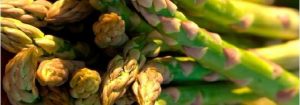ASPARAGUS, Mary Washington
Geography/History:
Asparagus has been used as a vegetable and medicine, owing to its delicate flavor, diuretic properties, and
more. It is pictured as an offering on an Egyptian frieze dating to 3000 BC. Still in ancient times, it was known
in Syria and in Spain. Greeks and Romans ate it fresh when in season and dried the vegetable for use in
winter; Romans would even freeze it high in the Alps, for the Feast of Epicurus. Emperor Augustus reserved
the “Asparagus Fleet” for hauling the vegetable, and coined the expression “faster than cooking asparagus” for
quick action.
Nutritional Value:
It is a good source of vitamin B, calcium, magnesium and zinc, and a very good source of dietary fibre, protein,
beta-carotene, vitamin C, vitamin E, vitamin K, thiamine, riboflavin, rutin,niacin, folic acid, iron,
phosphorus, potassium, copper, manganese and selenium, as well as chromium, a trace mineral that
enhances the ability of insulin to transport glucose from the bloodstream into cells. The amino
acid asparagine gets its name from asparagus, as the asparagus plant is relatively rich in this compound.
Sun: Full Sun in spring and fall/ Partial Shade in summer
Spacing: 12-18in
Height: 18cm (7in)
Soil Ph: 6.5-7.5
Days To Maturity: 730
Sowing Method: Direct Sow Outdoors
Planting/Growing Tips:
Keep the asparagus bed weed free by hand, rather than using a hoe, as the shallow roots are easily damaged.
Mulch the bed in late winter with weed-free compost to discourage weeds and to retain moisture. Consider
covering the bed from autumn to winter with an opaque weed mat to prevent annual weeds germinating.
In early spring, apply 100g per sq m (3oz per sq yd) of general fertilizer such as Growmore, or fish, blood and
bone. If growth is weak, repeat this application once harvesting has finished

